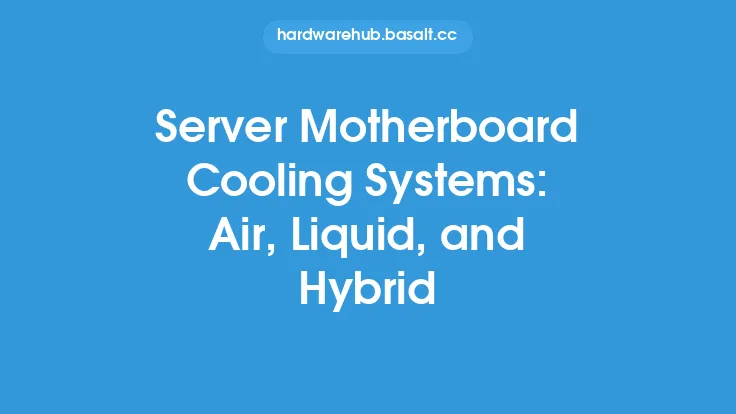When it comes to 24/7 overclocking, one of the most critical factors to consider is the cooling system. Overclocking pushes the hardware to its limits, generating excessive heat that can lead to reduced performance, damage, or even complete system failure. A reliable and durable cooling system is essential to maintain optimal temperatures, ensuring the longevity and stability of the overclocked components. In this article, we will delve into the cooling considerations for 24/7 overclocking, exploring the key aspects that impact reliability and durability.
Introduction to Cooling Systems
A cooling system's primary function is to dissipate heat generated by the overclocked components. There are two primary types of cooling systems: air-based and liquid-based. Air-based cooling systems use fans to circulate air through a heatsink, which absorbs heat from the component. Liquid-based cooling systems, on the other hand, use a liquid coolant to absorb heat, which is then transferred to a radiator, where it is dissipated. Both types of cooling systems have their advantages and disadvantages, and the choice between them depends on the specific overclocking setup and requirements.
Heat Transfer and Thermal Resistance
Heat transfer is a critical aspect of cooling systems, as it directly affects the temperature of the overclocked components. Heat transfer occurs through three primary mechanisms: conduction, convection, and radiation. Conduction is the transfer of heat between two objects in direct contact, while convection is the transfer of heat through a fluid medium, such as air or liquid. Radiation is the transfer of heat through electromagnetic waves. Thermal resistance, measured in degrees Celsius per watt (°C/W), is a key parameter in evaluating the effectiveness of a cooling system. A lower thermal resistance indicates better heat transfer and, consequently, lower temperatures.
Cooling System Components
A cooling system consists of several components, each playing a crucial role in maintaining optimal temperatures. The heatsink, a critical component, absorbs heat from the overclocked component and transfers it to the surrounding air or liquid. The fan, in air-based cooling systems, circulates air through the heatsink, enhancing heat transfer. In liquid-based cooling systems, the pump circulates the liquid coolant through the system, while the radiator dissipates heat from the coolant. The thermal interface material (TIM), applied between the heatsink and the overclocked component, fills microscopic gaps, ensuring optimal heat transfer.
Reliability and Durability Considerations
Reliability and durability are essential considerations when selecting a cooling system for 24/7 overclocking. A reliable cooling system should be able to maintain optimal temperatures, even under extreme overclocking conditions. Durability, on the other hand, refers to the cooling system's ability to withstand the rigors of continuous operation. Factors such as fan noise, vibration, and corrosion can impact the reliability and durability of the cooling system. Additionally, the cooling system's materials, design, and construction should be able to withstand the thermal stresses and strains imposed by 24/7 overclocking.
Maintenance and Upkeep
Regular maintenance and upkeep are crucial to ensuring the reliability and durability of the cooling system. Dust buildup, a common issue in air-based cooling systems, can significantly reduce heat transfer, leading to increased temperatures. Cleaning the heatsink, fans, and radiators regularly can help maintain optimal performance. In liquid-based cooling systems, the coolant should be checked and replaced periodically to prevent corrosion and maintain its thermal properties. Monitoring the cooling system's performance and adjusting its settings as needed can also help prevent overheating and ensure reliable operation.
Conclusion
In conclusion, cooling considerations play a vital role in 24/7 overclocking, directly impacting the reliability and durability of the overclocked components. A well-designed and well-maintained cooling system can ensure optimal temperatures, even under extreme overclocking conditions. By understanding the key aspects of cooling systems, including heat transfer, thermal resistance, and cooling system components, overclockers can make informed decisions when selecting and maintaining their cooling systems. Regular maintenance and upkeep, combined with a deep understanding of the cooling system's mechanics, can help ensure reliable and durable operation, maximizing the performance and longevity of the overclocked components.





